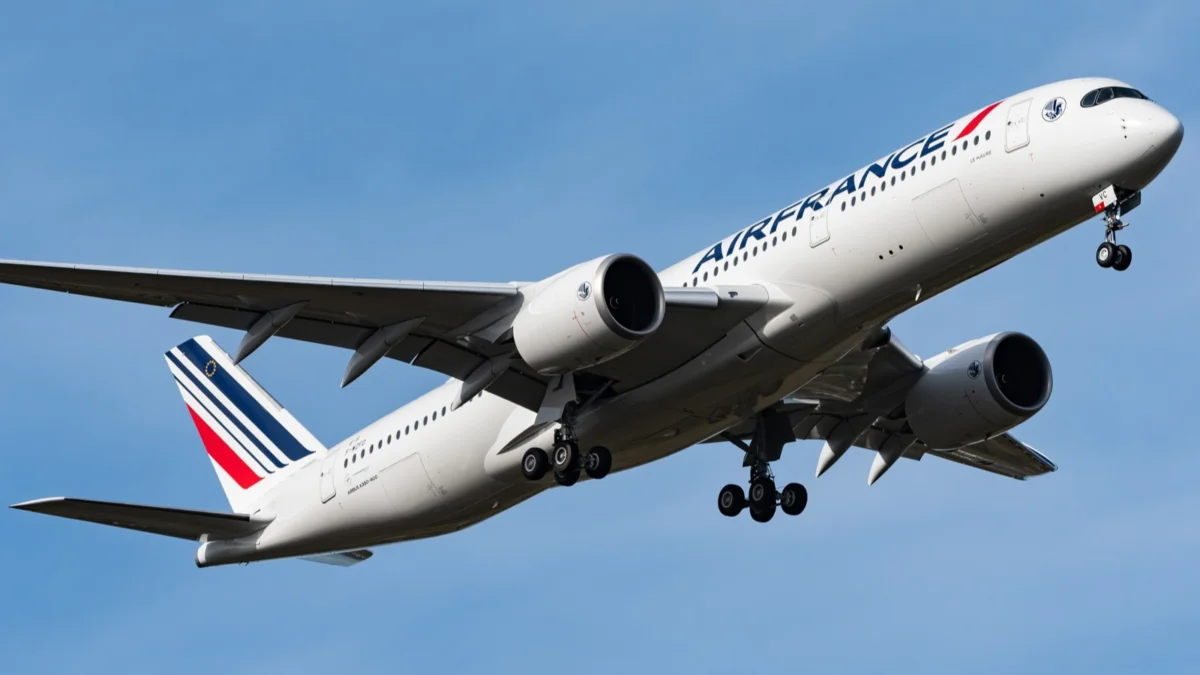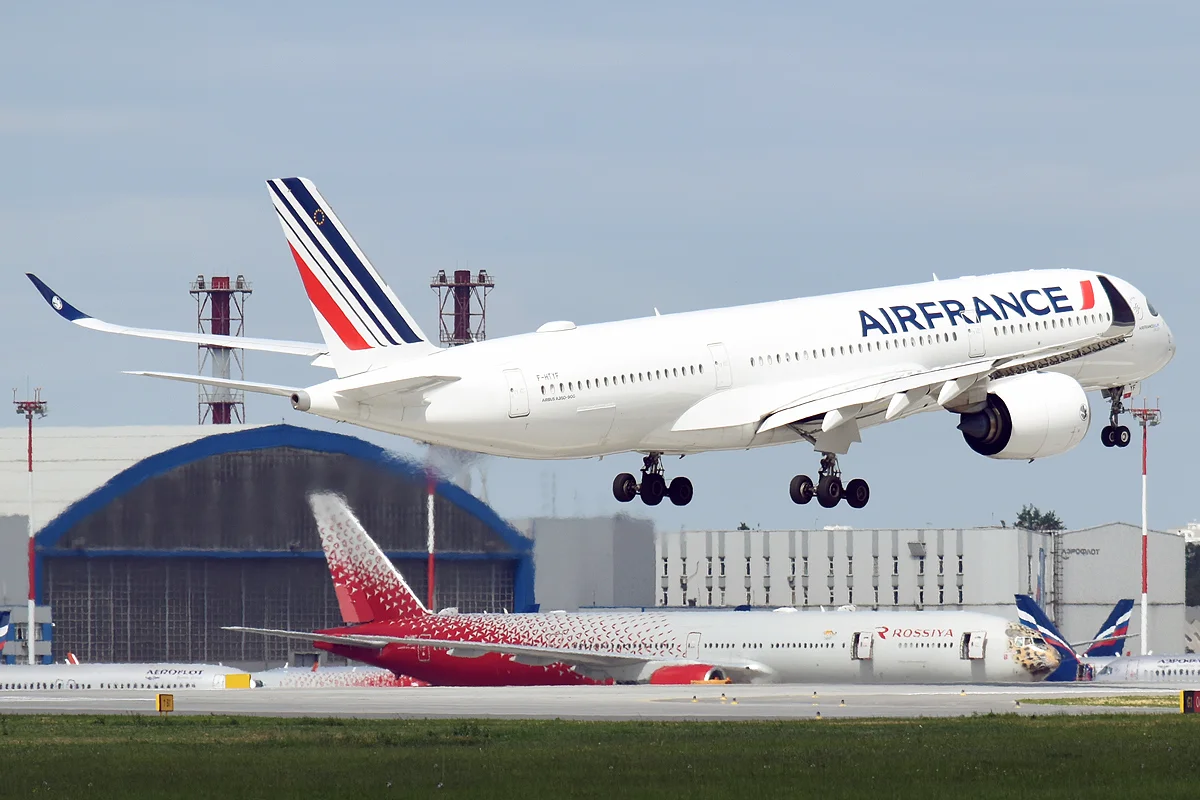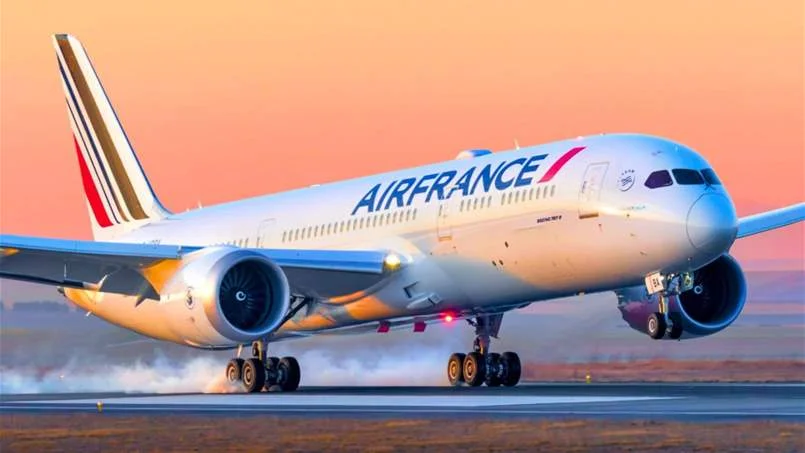Introduction: The Air France A350 Chicago Turnback Incident
Air France A350 Chicago flight return: In mid-2025, a high-profile aviation event caught the attention of news outlets and aviation fans: an Air France A350 flight bound for Chicago O’Hare (ORD) was turned back mid-route and returned to Paris Charles de Gaulle (CDG). Reports indicated that the aircraft was denied landing clearance in Chicago, prompting the unscheduled reversal.
This kind of in-flight reversal (also called a return flight or turnback) throws many questions into the spotlight: What triggered the return? Was it a technical fault, procedural / bureaucratic issue, air traffic control denial, or another cause? How did passengers respond? What is the experience on board an Air France A350? And what lessons does this incident offer for aviation operations, regulation, and communications?
In this article, we’ll examine:
- What happened on the Air France A350 Chicago flight return
- The technical and operational context of the Airbus A350 in Air France service
- The passenger experience — amenities, comfort, and implications of the disruption
- Possible causes of the turnback (clearance denial, bureaucracy, technical, regulatory)
- Airline response, communication, and crisis management
- Risk, reputation, and safety lessons
- Comparative cases: other long-haul turnbacks
- Impacts on Air France, regulatory bodies, and passengers
- Recommendations and what to watch going forward
- FAQs
Let’s dive in and unpack all the facets of this event.
1. What Actually Happened: The Return Flight Narrative
1.1 Flight Details & Timeline
The flight in question is often referenced as Air France AF136 (or a variant) departing Paris Charles de Gaulle (CDG) toward Chicago O’Hare (ORD).
According to aviation tracking and commentary:
- The aircraft departed CDG and flew for a number of hours toward Chicago.
- At some point mid-route, it was instructed or decided to turn back and return to Paris.
- Some reports claim the cause was denied clearance to land at Chicago, or paperwork / procedural issues, rather than a purely technical malfunction.
- The time aloft and distance covered have varying accounts. Some suggest about 4 hours before returning, not a full halfway of the transatlantic route.
- The event generated social media posts, aviation watchers’ commentary, and retrospective analyses.
A key point: the return was not due to a crash or major failure (no indication of emergency landing), but an operational or procedural reversal.
1.2 Official / Media Statements
Air France initially cited “operational reasons” for the return, which is a generic phrase often used to cover a range of possibilities (weather, ATC, maintenance, regulatory).
In some commentary, a more specific reason was offered: the aircraft was apparently not yet on the approved U.S. ops sheet (i.e. the registration or flight number not cleared under U.S. regulatory permissions), hence denied clearance to enter U.S. airspace.
According to one LinkedIn analysis, the turnback “wasn’t a fluke or technical failure — it was a procedural hurdle rooted in U.S. entry rules.”
Another take is that a clerical / paperwork error triggered the denial — e.g. the tail number or aircraft registration wasn’t properly filed with U.S. authorities.
So while multiple theories exist, the strongest signal is toward a regulatory / procedural clearance issue rather than catastrophic technical failure.
1.3 Reaction & Passenger Impacts
Passengers reportedly found themselves midflight when the return decision came. Some social media posts and aviation forums expressed disbelief and confusion.
Operationally, a reversal imposes challenges: extended fuel usage, crew duty times, passenger welfare, re-accommodation, communication, and handling refunds or accommodations.
Thus, this event became more than a flight alteration — it entered into the public narrative of airline reliability, regulatory oversight, and passenger expectations.
2. The Air France Airbus A350: Background & Capabilities

To understand the operational context, it helps to review the Airbus A350 aircraft as used by Air France, its configuration, features, and role in the fleet.
2.1 Air France’s A350 Fleet & Cabin Renewal
Air France embarked on modernizing its long-haul fleet, and part of that strategy is introducing new Airbus A350-900 aircraft with updated cabins and features.
By 2023, Air France began rolling out its new cabin standard on the A350.
Some key stats:
- Air France ordered 41 A350-900s.
- As of mid-2023, the 21st delivered A350 (named “Aix-en-Provence”) included the “door 1 XL” area configuration, improving galley, lavatory, crew rest, and passenger comfort.
- This cabin revamp is part of Air France’s vision that by 2030, latest generation aircraft (including A350) will represent ~70% of the fleet.
Hence, the A350 is intended as a flagship for long-haul service for Air France.
2.2 Cabins & Layouts
Air France uses several seat map configurations on its A350s.
Two common configurations:
- Configuration A: ~324 seats total: 34 Business, 24 Premium Economy, 266 Economy.
- Configuration B: ~292 seats: 48 Business, 32 Premium Economy, 212 Economy.
The newer cabin standard (for the delivered A350s) aligns with the 292-seat version: 48 in Business, 32 in Premium, 212 in Economy.
Cabin features & amenities:
- In Business class, the new seats convert to full-flat beds (≈ 2 meters length) and feature sliding doors for enhanced privacy
- Seats include USB-A / C ports, Bluetooth connectivity, WiFi, large HD / 4K touchscreens, and controls for seat, lighting, and window shading.
- Premium cabin (aka “Premium Economy” or “Premium”) offers more legroom, recline capabilities (121°), upgraded seats, and priority services.
- Economy class seats use improved ergonomic foams, anti-glare 4K screens, Bluetooth connectivity, USB charging, and device holders.
- The newer cabins emphasize materials like wool, French leather, brushed aluminium; more storage including foot-of-seat compartments; and improved galley / lavatory design.
Air France markets these A350s as offering a quieter cabin, lower CO₂ emissions, greater range and passenger comfort.
Hence, the A350 in Air France’s service is a modern, premium long-haul aircraft — one expected to perform reliably even on transatlantic sectors like Paris to Chicago.
2.3 Performance and Operational Capabilities
Key performance metrics of the Airbus A350:
- Range & efficiency: The A350 family is known for long-range capabilities and fuel efficiency, making it well-suited for long-haul flights with reduced environmental footprint.
- Cruising speed: Mach ~0.85 typical for such wide-body aircraft. Air France lists cruising altitude ~10,700 meters (≈ 35,000 ft) for its A350s.
- Cabin noise, comfort: The new standard cabins are touted as among the quietest in their category, and door/galley design improvements aim to isolate cabin from noise and disturbance.
These operational strengths mean that an A350 should handle routes like Paris–Chicago with relative resilience, barring external or regulatory constraints.
Thus, when an A350 returns mid-route, it signals that the cause was not a baseline mismatch of capability but an exceptional constraint.
3. Passenger Experience & Effect of a Mid-Flight Turnback
A long-haul flight being reversed midair causes both logistical and human impact. Let’s detail how this plays out for passengers, especially on an A350.
3.1 The Promise of Flying A350: Comfort & Amenities
If the flight had proceeded normally, passengers would enjoy the modern amenities of the A350:
- Spacious, ergonomic seating: In Business, full-flat beds with privacy doors; in Premium, generous recline and legroom; in Economy, improved cushions and screens.
- In-flight entertainment & connectivity: Systems include HD / 4K touch screens, Bluetooth, USB charging, WiFi (where enabled) and device integration.
- Service & catering: Air France is known for premium dining on long-haul flights, especially in business class (Michelin-inspired menus, multiple services)
- Cabin environment: Quieter cabin, improved storage, better lavatory layout, and ambient design to reduce fatigue
Thus, passengers boarded expecting a high-end experience for the Paris to Chicago journey.
3.2 Psychological & Operational Shock of Turnback
But a mid-air return disrupts expectations severely:
- Uncertainty & stress: Passengers may not know immediately why the flight is reversing, leading to anxiety, speculation, or confusion.
- Communication gaps: Airlines must update passengers with reasons, timing, and next steps. Poor communication can exacerbate frustration.
- Physical inconvenience: Extended time aboard the aircraft, possibly without full service, food, or restroom access as in standard flight.
- Disrupted arrival plans: Passengers may miss connecting flights, hotel bookings, ground transport, or appointments in Chicago.
- Reaccommodation & refunds: The airline must arrange new flights, compensation, hotels, meals, etc.
In a well-managed system, crew and ground staff mitigate the disruption. But the perception and reputation impact often linger longer than the delay.
3.3 Specifics for This Air France Incident
While full passenger-level reports are limited publicly, some insight emerges:
- Social media and aviation watchers posted images or commentary about the reversal.
- The airline’s statement of “operational reasons” is non-specific, which may frustrate affected passengers seeking clarity.
- Because many accounts suggest the return was for procedural/clearance reasons rather than technical failure, the disruption was avoidable in principle, which may aggravate perceptions of airline competence.
Thus, while passengers may still rate the in-flight amenities positively, the disruption overshadowed the comfort.
3.4 Comparative Reports: How Turnbacks Are Handled
Looking at other long-haul turnbacks, best practices include:
- Prompt, transparent communication explaining cause and next steps
- Offering meals, restrooms, water aboard or via diversion
- Assistance with onward flights, rebooking, lodging, accommodation if needed
- Frequent updates via crew announcements or digital messaging
- Elevating vulnerable passengers (elderly, connecting transfers) for priority help
The better an airline handles the disruption, the less damage to reputation.
Given Air France’s profile, one would expect a robust contingency for such events, but the clarity of execution matters.
4. Possible Causes: Why Did the A350 Turn Back?
We now examine potential root causes — technical, regulatory, procedural, or human factors — that could explain the return of the Air France A350 en route to Chicago.
4.1 Technical Malfunction or System Failure
A mid-flight mechanical, systems, or avionics malfunction could force a return:
- Engine warning, hydraulic system anomaly, structural issue
- Flight control, navigation, or communications system failure
- Fuel imbalance, leak, or warning
- Pressurization or environmental system failure
However, public information does not strongly support a technical failure here. The reported statements and commentary lean toward procedural / clearance issues instead of catastrophic technical failure.
That said, one cannot fully rule out a minor technical anomaly (e.g. caution indicator) that combined with clearance complications prompted the return.
4.2 Denied Landing / Clearance Refusal
One of the strongest theories is that Air Traffic Control (or U.S. regulatory authorities) denied permission for the aircraft to land at Chicago, resulting in the need to turn back:
- Possibly because the aircraft registration / tail number was not on the U.S. operational authorization list. Some commenters on aviation forums suggest the aircraft was “a new A350 that Air France hadn’t added to their ops sheet with the U.S. yet” — and so it was not cleared under U.S. regulatory filings.
- Airlines must file operating authorizations, including tail numbers, flight plans, regulatory data, insurance, etc., to operate in U.S. airspace. If a mismatch or omission occurs, denial can follow.
- The LinkedIn analysis specifically frames the return as a procedural hurdle rooted in U.S. entry rules rather than a mechanical failure.
This cause aligns well with the public narrative and the lack of reports about mechanical damage.
4.3 Regulatory / Bureaucratic / Paperwork Errors
Closely linked to clearance, procedural missteps in documentation may trigger denials even if the aircraft itself is airworthy:
- The airline may have failed to register the tail number in time or correctly with U.S. regulatory agencies (FAA, TSA, Customs & Border Protection)
- Flight plan errors, missing permits, or missing overflight / landing authorizations
- Administrative mismatch between scheduled fleet updates and operations manifests
- Delays or oversight in filling in new aircraft into the airline’s U.S. “ops sheet” or route authorization filings
Some aviation forum commentary supports this: a commenter suggests the return was “a clerical error that should have been caught before the aircraft was assigned to the flight.”
Thus, a paperwork or approval oversight is a plausible root trigger.
4.4 Human / Operational Decision
Sometimes the decision to return is a conservative or precautionary judgment by the crew or airline, prompted by:
- Weather, wind, turbulence, or forecasts ahead
- ATC congestion or slot denial
- Fuel reserve margins or route deviations
- Crew duty time, legal rest constraints
- A combination of marginal technical indication plus regulatory concern
If the crew or operations center judged the risk or clarity of clearance too uncertain, they might choose to turn back rather than proceed into possible denial or detour complexity.
Given the lack of explicit mechanical error reports, a mix of clearance uncertainty + procedural oversight + conservative decisionmaking is a credible composite cause.
4.5 Likelihood & Synthesis
Considering all available evidence:
- The aircraft likely was operationally healthy (no public reports of technical failure)
- The best published narrative centers on clearance / regulatory denial due to paperwork or tail number registration issues
- The decision was probably conservative: rather than risk a denied approach or forced diversion, the flight was reversed early
- The root trigger appears to be a bureaucratic / documentation mismatch rather than a catastrophic system failure
Thus, the incident becomes a cautionary tale for operational oversight, compliance systems, and intergovernmental aviation coordination.
5. Airline Response, Communication & Crisis Management

When a high-profile turnback occurs, how the carrier responds in communication, customer care, and transparency strongly affects reputation.
5.1 Public Statements & Transparency
In this case:
- Air France issued a brief statement attributing the return to “operational reasons”, a broad and non-specific justification.
- The vagueness allows room for internal or regulatory ambiguity, but may also frustrate passengers seeking clarity.
- Independent analysts and aviation watchers speculated more specific causes (clearance / regulatory paperwork) in the absence of fuller airline disclosure.
Ideally, a more detailed, authoritative post-mortem would reassure passengers and aviation stakeholders.
5.2 Compensation, Rebooking & Passenger Care
An airline’s operational responsibility includes:
- Rebooking affected passengers onto alternative flights
- Providing hotel accommodations, meals, transfers, if delay requires overnight stay
- Customer service and compensation per contract of carriage or regulatory obligations
- Messaging via email, app notifications, social media to guide affected travelers
No clear public record indicates exactly how Air France managed these steps in this incident. But given the premium status of the route and aircraft, one expects standard procedures were activated.
5.3 Internal Root Cause Review & Mitigation
Beyond immediate passenger care, the airline must:
- Conduct internal investigation: documentation logs, ATC communications, operational manifests
- Identify lapses (if any) in regulatory filing, manifest management, compliance oversight
- Revise procedures to avoid recurrence (pre-flight checks, regulatory coordination teams, documentation audits)
- Train teams (dispatch, operations, compliance) for future checks
A failure of regulatory paperwork or manifest oversight is a serious procedural weak point, especially for transatlantic operations; remediation is critical.
5.4 Reputation & Trust Management
From a brand perspective:
- The turnback is a reputational risk, particularly for a flagship aircraft model and long-haul route
- Proactive, transparent communication (once internal review concludes) helps restore passenger trust
- Highlighting safety, no technical failures, and operational caution can reassure customers
- Compensation and responsiveness to affected travelers often shapes enduring perception more than the incident itself
In effect, how the airline handles the “after” matters as much as what happened.
6. Risk, Safety & Lessons for Airlines and Regulators
This incident offers several lessons and risk considerations applicable to airlines, regulators, and aviation operations.
6.1 The Criticality of Regulatory Compliance & Documentation
- All flights, especially international ones, require precise regulatory filings (tail numbers, flight plans, overflight permits, landing authorizations).
- Failing to update a new aircraft entry into U.S. operational manifest can halt service.
- Airlines must maintain rigorous compliance tracking, especially when integrating new aircraft into existing routes.
This case underscores that regulation and paperwork failures can equal mechanical failures in causing disruption.
6.2 Preflight Regulatory Checks as Safety Controls
Before departure, airlines should verify:
- That the aircraft registration is valid in destination and overflight jurisdictions
- That all permits, customs, immigration, and traffic control authorizations are in place
- That flight dispatch systems flag mismatches or omissions
- That operations control reviews manifest correctness
A robust checklist and clearance audit could have caught the discrepancy before takeoff.
6.3 Conservative Decisionmaking vs Risk Tolerance
The crew or operations center likely chose a conservative decision to return rather than risk being denied approach mid-route or stuck in holding patterns.
This approach embodies the safety-first doctrine: when regulatory clarity is uncertain, revert rather than risk violation or forced diversion.
6.4 Communication & Contingency Planning Preparedness
- Airlines must be prepared to communicate clearly mid-flight with passengers
- Contingency plans (alternate flights, hotel, rebooking) must be prearranged for long-haul operations
- Operations must consider cost, passenger welfare, and brand impact in such reversals
Turning back mid-ocean or mid-Atlantic is costly and disruptive; effective crisis planning is essential.
6.5 Data Transparency & Independent Oversight
- Publishing post-event reports, findings, and lessons improves public trust
- Regulators may review the case for possible compliance violations or gaps
- Third-party aviation watchdogs and flight tracking systems often shed additional light
Such transparency helps elevate industry standards and passenger confidence.
6.6 Redundancy in Regulatory Systems
To reduce risk, airlines might:
- Duplicate manifest compliance systems
- Cross-check regulatory filings with destination / ATC systems
- Use automated alerts for mismatches in fleet vs authorization
- Build redundancy in supervision between dispatch, operations, and compliance units
Given the global complexity of airline operations, these redundancies act as fail-safes.
7. Comparative Cases: Other Transatlantic Turnback Events
While turnbacks are rare, examining analogous events gives perspective on how airlines respond and lessons learned.
7.1 KLM 787 Turnback Due to Cabin Pressure — 2018
In 2018, a KLM Boeing 787 scheduled for non-stop Amsterdam to Salt Lake City experienced a cabin pressure anomaly and turned back to Amsterdam. The crew prioritized safety over continuation. The airline re-accommodated passengers and investigated the cause. This case shows mechanical or system faults can trigger returns even on premium aircraft.
7.2 Air India A350 U.S. Denial (Hypothetical)
Airlines deploying new aircraft sometimes face U.S. regulatory clearance delays. If an A350 or another widebody is not fully cleared in U.S. operational manifest, the denial could force rerouting or return if already en route. This mirrors the procedural hypothesis for the Air France case.
7.3 United / Delta Diverted/Turned Returns
Major U.S. airlines occasionally turn back flights for crew duty time limits, severe weather forecasts, or technical issues. Comparative study shows that the decision is often a mix of regulatory, safety, and cost judgments.
From those cases, best practices stand out:
- Early detection of anomalies or regulatory mismatches
- Well-trained crew with authority and protocols for turnbacks
- Contingency for passenger care
- Transparent post-incident communication
The Air France A350 turnback is not unique in principle, but unusual given the aircraft and route.
8. Impacts on Air France, Aviation Regulation & Passengers
What ripple effects arise from this event—on the airline, the regulatory ecosystem, and passengers?
8.1 Brand & Customer Confidence
- Trust among business and premium travelers may suffer; passengers may hesitate to choose Air France or A350 flights on the same route
- Frequent flyers and loyalty program members could demand more clarity or compensation
- Reputation messaging will matter in recovery
However, transparent, effective handling and follow-up corrections can mitigate long-term damage.
8.2 Operational Audit & Airline Policy Shifts
- Air France will likely reexamine its compliance manifest systems, dispatch procedures, and regulatory oversight teams
- Policies might be updated to require stricter pre-departure regulatory checks
- New internal audits or changes in operational authority may be instituted
In effect, lessons from this turnback may cascade into tighter controls and process changes.
8.3 Regulatory Attention & Oversight
- U.S. aviation regulators (FAA, TSA, CBP) and French / European regulators may review whether regulatory filings or permissions were mishandled
- Industry observers may interpret this as warning about oversight of fleet modernization and paperwork systems
- Airlines flying transatlantic routes may re-check if their own manifest and clearance procedures are sufficiently robust
Hence, this becomes a case study in the regulatory dimension of global airline operations.
8.4 Passenger Disruption & Compensation Claims
- Affected passengers may file claims for reimbursement, compensation, or goodwill gestures
- Some may claim missed connections, lodging costs, or personal inconvenience
- Legal or contract-of-carriage frameworks may determine eligibility
For premium or business travelers especially, the perceived inconvenience might weigh heavily in post-incident satisfaction.
8.5 Industry Awareness & Best Practices Sharing
- Aviation trade publications, pilot groups, and operations forums will examine and dissect the case
- Airlines and regulatory bodies may share findings so others avoid similar pitfalls
- This event may feature in airline safety / operations conferences as a cautionary case
As such, while localized, the event may influence broader aviation practices.
9. What to Watch Going Forward: Recommendations & Monitoring
To assess impact and anticipate future incidents, stakeholders (airlines, regulators, passengers) should watch for the following:
9.1 Formal Post-Incident Report
A detailed internal or regulator-backed report from Air France or French aviation authority clarifying root causes, decision logic, and remedial actions
Transparency on whether documentation, regulatory compliance, or manifest protocols were at fault
Such a report can settle speculation and restore trust.
9.2 Operational Procedure Updates
- Updated standard operating procedures (SOPs) regarding pre-flight regulatory checks
- Enhanced manifest systems and fleet authorization tracking
- Dispatch / operations changes to flag tail number mismatches or clearance omissions
If Air France publishes or communicates such updates, it signals seriousness of response.
9.3 Compensation & Customer Redress
- The scale and scope of compensation offered to affected passengers
- How efficiently rebooking, lodging, and reimbursement are handled
- Whether Air France extends future goodwill gestures to affected customers
These actions will influence lasting public perception.
9.4 Regulatory / Legal Review
- Whether U.S. or European regulators launch investigations into compliance lapses
- Whether fines, sanctions, or procedural mandates are introduced for Air France or others
- Whether new rules emerge to tighten clearance manifest procedures
A heightened regulatory environment could follow.
9.5 Flight Tracking & Operational Audits
- Flight tracking services (FlightAware, Flightradar24) may release detailed paths, turnback coordinates, or timing data
- Independent aviation analysts may model fuel usage, risk profiles, and prior warning signs
- Comparison with future flights may show tightened or improved preflight compliance
Monitoring these will help validate whether procedural reforms are working.
9.6 Passenger Sentiment & Brand Metrics
- Passenger reviews, social media sentiment, and press coverage will reflect whether the event has enduring reputation impact
- Brand recovery efforts by Air France via marketing, transparency, loyalty incentives, and service improvement
- Rebooking patterns: whether travelers avoid Air France Chicago A350 routes in short term
Tracking these will show how resilient the airline’s brand is post-incident.
9.7 Comparable Airline Incidents
- Whether other airlines suffer similar regulatory / manifest-related turnbacks
- Whether industry best practices evolve in response
- Whether airlines adopting new aircraft (e.g. A350, 787) face similar entanglements
If this becomes a systemic risk vector, broader industry changes may follow.
10. FAQs & Summary
FAQs
Q1: Did the Air France A350 actually reach Chicago before turning back?
No — reports suggest the aircraft turned back mid-route and did not land in Chicago.
Q2: Was the turnback caused by mechanical or safety issues?
Available evidence suggests the turnback was driven more by regulatory / procedural clearance issues (e.g. aircraft not on U.S. ops manifest) rather than a catastrophic technical failure.
Q3: How long was the flight in the air before turning back?
Estimates vary; some reports suggest around 4 hours or so.
Q4: How many passengers were affected?
Exact passenger count is not publicly confirmed in available sources.
Q5: Will Air France avoid sending A350s to U.S. again?
No clear indication of that. Rather, the airline will likely refine regulatory compliance and manifest procedures to prevent recurrence.
Summary
The Air France A350 Chicago flight return stands out as a dramatic, rare event: a modern wide-body flagship aircraft reversed mid-transatlantic flight, not because of mechanical failure but seemingly due to regulatory / clearance paperwork mismatch or denial. The case illustrates the critical intersection of aviation operations, regulatory compliance, and airline reputation risk.
Key takeaways:
- The Airbus A350 in Air France service is a modern, well-equipped long-haul aircraft; turning it back mid-route signals an extraordinary constraint.
- Passengers expecting a premium journey experienced disruption, uncertainty, and logistical fracture due to the return.
- The strongest causal hypothesis is clearance denial / manifest paperwork error, not technical failure.
- Airline response (communication, rebooking, compensation) plays a huge role in mitigating reputational damage.
- The incident underlines the necessity of meticulous regulatory compliance, redundancy in dispatch / manifest systems, preflight checks, and conservative decisionmaking under uncertainty.
- Monitoring post-incident reporting, regulatory reaction, and airline procedural updates will show how the industry learns from it.
In sum, this event is a cautionary episode: even with advanced aircraft and long-haul routes, operational and regulatory discipline remains just as crucial as mechanical reliability.








